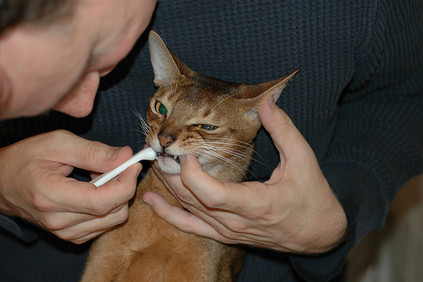Become familiar with Remedies for Cat Unpleasant Mouth Odor

Once your cat seems to have stubborn cat bad breath, it’s the perfect time to take its well being into your personal hands. Get to know which therapies for cat bad breath is right for your pet.
Bad cat breath also known as halitosis is a well being dilemma involving an uncomfortable odor from your mouth. Your cat’s bad breath is brought on by oral issues but occasionally can be caused by other diseases.
It is important to determine the causes of cat bad breath to effectively treat the problem such as:
Remedy of Cat Poor Breath
The right diagnosis and trigger of your cat bad breath is essential since this is where therapy depends. Probably the most favorable therapy of any persistent condition ought to be based on the known trigger of the disease. Some therapy for cat bad breath consist of:
1. Clean your cat’s teeth daily. Use mouth items specially created for cats for example finger brushes, cat toothpaste, oral options, and amongst others.
2. Spray 0.12 percent of chlorhexidine resolution into your cat’s mouth as soon as per day. Do this for seven to fourteen days. Your vet should prescribe this remedy.
3. Feed your cat raw chicken necks or bones but be sure to supervise to avoid any choking occurrence.
4. Removal of any alien objects stuck in your cat’s teeth or gums.
5. Have your cat undergo periodontal therapy and root preparing. This therapies involves teeth cleaning or scraping the teeth under the gums.
6. Treat or manage other underlying trigger of cat bad breath listed above.
7. Make an annual go to for your cat to see a vet.
For prolonged cat bad breath, have your cat check by a vet to locate other underlying diseases that could possibly be causing it.
Bad cat breath also known as halitosis is a well being dilemma involving an uncomfortable odor from your mouth. Your cat’s bad breath is brought on by oral issues but occasionally can be caused by other diseases.
It is important to determine the causes of cat bad breath to effectively treat the problem such as:
- Inflammation of the tissue all around the tooth or periodontitis
- Inflammation of the gums known as gingivitis
- Abscessed tooth or teeth
- Foreign body caught within the gums for example bone pieces
- Oral ulceration
- Tumors on the mouth
- Kidney disease
- Diabetes
- Liver illness
- Lung disease
- Severe kidney disease
Remedy of Cat Poor Breath
The right diagnosis and trigger of your cat bad breath is essential since this is where therapy depends. Probably the most favorable therapy of any persistent condition ought to be based on the known trigger of the disease. Some therapy for cat bad breath consist of:
1. Clean your cat’s teeth daily. Use mouth items specially created for cats for example finger brushes, cat toothpaste, oral options, and amongst others.
2. Spray 0.12 percent of chlorhexidine resolution into your cat’s mouth as soon as per day. Do this for seven to fourteen days. Your vet should prescribe this remedy.
3. Feed your cat raw chicken necks or bones but be sure to supervise to avoid any choking occurrence.
4. Removal of any alien objects stuck in your cat’s teeth or gums.
5. Have your cat undergo periodontal therapy and root preparing. This therapies involves teeth cleaning or scraping the teeth under the gums.
6. Treat or manage other underlying trigger of cat bad breath listed above.
7. Make an annual go to for your cat to see a vet.
For prolonged cat bad breath, have your cat check by a vet to locate other underlying diseases that could possibly be causing it.
